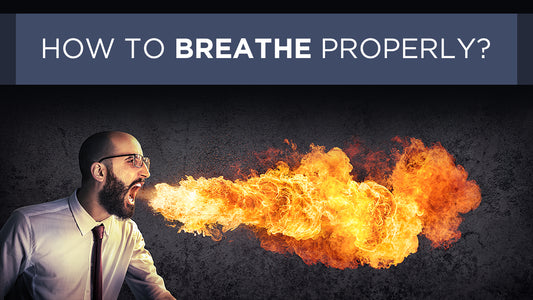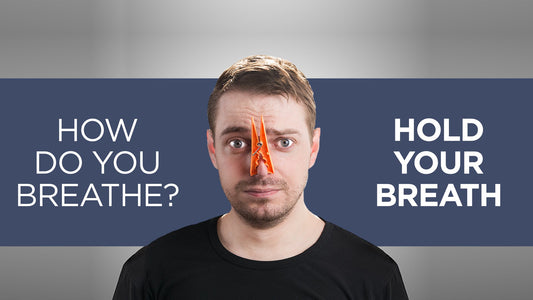
Mouth breathing causes colds
In our language we can often find a deeper understanding of various functions of the body. The meaning of the word cold, for example, is not only a common infection but also a low temperature. This is logical, as many of us have noticed that the risk of catching a cold increases when we get cooled. And it turns out that it is often a cold nose that causes a cold.
Research shows that the rhinovirus, which is known to cause colds and infections in the upper respiratory tract, grows when the nose cools down. The colder it is in the nose the less the immune system is exerting itself, which creates a favorable environment for the rhinovirus to multiply.
The nose – an efficient heat exchanger and self-cleaning bacteria filter

The nose can be compared to a highly efficient heat exchanger that warms up and moistens the air. When inhaling, the nose becomes cooled and dry as it moistens and heats the inhaled air, which is usually cooler than our body temperature. When we exhale, the temperature inside the nose is raised, and the area is moisturized by the 37 degree Celsius and 100% moist air being returned from the lungs.
Furthermore, the air we breathe in is full of bacteria, viruses, chemicals and other particles. About 75 % of all particles and viruses in the air are filtered out as they pass through the sticky mucous membranes and cilia of the nose.
Since the cilia move the particles to the pharynx and we swallow them or the particles follow the exhalation air as we exhale through the nose, the nose also acts as a self-cleaning bacteria filter.
A nose that isn't used stops working properly
One of the effects of mouth breathing is that a nose that is not being used stops functioning properly. If you don’t use it, you lose it. If we breathe in through the nose and out through the mouth, the nose will not restore it’s warmth and moisture upon exhalation. And if we breathe both in and out through the mouth, the nose will be constantly cold and dry.
So if we are afraid of, for example, catching a cold, it is not enough to wash our hands if we, at the same time, have our mouths open and breathe in 10,000-20,000 liters of unfiltered air every day, containing up to 100 billion particles or more. It’s a bit like filtering mosquitoes and swallowing camels!
A lot of mucus is also produced in the nose. If the air does not circulate through the nose and the mucus is not cleaned out, it may lead to infections such as sinusitis and ear infection.
As we breathe through the mouth, the air goes unfiltered into the lungs. In other words, we skip our body’s first line of defense against intruders
The further down the trachea and into the lungs the particles from the inhaled air end up, the greater the risk of getting inflammation and infections. Given the lungs’ enormous absorption area of 50-100 square meters, about the size of a tennis court, it is critically important that they are kept free of viruses and bacteria. A bit incisive, you can say that it is as natural to breathe through your mouth as it is to eat through your nose.

What can you do for yourself?
- Improve your breathing. Assess your own breathing and become aware of how well your airways work by answering the 20 questions in the Breathing and Health Index Questionnaire. If the result shows that your breathing habits have room for improvement, you will probably benefit greatly from doing the 28-Day Conscious Breathing Retraining.
- Tape your mouth at night. We often catch colds at night, and one reason is that we have our mouths open when we sleep, which will cool our noses. Taping your mouth at night with Sleep Tape is an extremely simple yet very powerful tool. As it is not easy to keep an eye on your breathing while you are asleep, using Sleep Tape will ensure that your mouth stays closed during the night so that you will breathe only in and out through your nose.
- Hum. In case of impaired breathing, air circulation and the pressure in the nose and sinuses deteriorate, creating a breeding ground for bacterial growth and inflammation. Humming can, then, have a positive impact on the function of the nose. This leads, namely, to a dramatic increase of the flow of air through the sinuses and increases the levels of nitric oxide (NO) in the nose 15-20 fold. NO has both a strong antiviral and antibacterial effect. Here is a simple humming exercise.
- Unblock a stuffy nose. A clogged or narrow nose is usually an indication that breathing is not optimal. In the nose, below the nasal turbinates, there are erectile tissue. As you improve your breathing, the erectile tissue in the nose will decrease in size and the inside of the nose will feel less crowded. Read more about how to unblock a stuffy nose.
This article is based on the book Conscious Breathing.
Scientific references
| Title | Temperature-dependent innate defense against the common cold virus limits viral replication at warm temperature in mouse airway cells. Link to full text |
| Journal | Proceedings of the National Academy of Sciences (PNAS), Jan-2015 |
| Author | Iwasaki A och medarbetare |
| Significance | Rhinovirus is the most frequent cause of the common cold, as well as one of the most important causes of asthma exacerbations. Most rhinovirus strains replicate better at the cooler temperatures found in the nasal cavity than at lung temperature, but the underlying mechanisms are not known. Using a mouse-adapted virus, we found that airway epithelial cells supporting rhinovirus replication initiate a more robust antiviral defense response through RIG-I–like receptor (RLR)–dependent interferon secretion and enhanced interferon responsiveness at lung temperature vs. nasal cavity temperature. Airway cells with genetic deficiencies in RLR or type I interferon receptor signaling supported much higher levels of viral replication at 37 °C. Thus, cooler temperatures can enable replication of the common cold virus, at least in part, by diminishing antiviral immune responses. |
| Abstract | Most isolates of human rhinovirus, the common cold virus, replicate more robustly at the cool temperatures found in the nasal cavity (33-35 °C) than at core body temperature (37 °C). To gain insight into the mechanism of temperature-dependent growth, we compared the transcriptional response of primary mouse airway epithelial cells infected with rhinovirus at 33 °C vs. 37 °C. Mouse airway cells infected with mouse-adapted rhinovirus 1B exhibited a striking enrichment in expression of antiviral defense response genes at 37 °C relative to 33 °C, which correlated with significantly higher expression levels of type I and type III IFN genes and IFN-stimulated genes (ISGs) at 37 °C. Temperature-dependent IFN induction in response to rhinovirus was dependent on the MAVS protein, a key signaling adaptor of the RIG-I-like receptors (RLRs). Stimulation of primary airway cells with the synthetic RLR ligand poly I:C led to greater IFN induction at 37 °C relative to 33 °C at early time points poststimulation and to a sustained increase in the induction of ISGs at 37 °C relative to 33 °C. Recombinant type I IFN also stimulated more robust induction of ISGs at 37 °C than at 33 °C. Genetic deficiency of MAVS or the type I IFN receptor in infected airway cells permitted higher levels of viral replication, particularly at 37 °C, and partially rescued the temperature-dependent growth phenotype. These findings demonstrate that in mouse airway cells, rhinovirus replicates preferentially at nasal cavity temperature due, in part, to a less efficient antiviral defense response of infected cells at cool temperature. |






